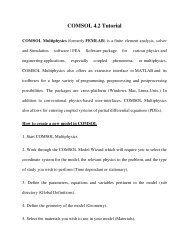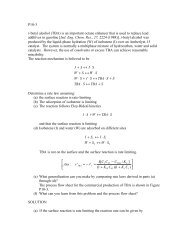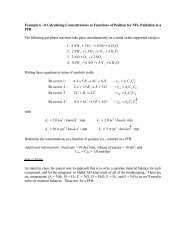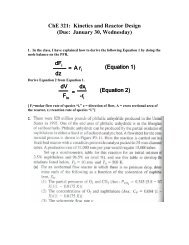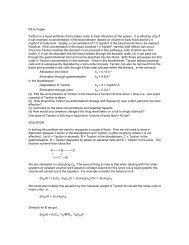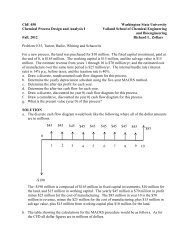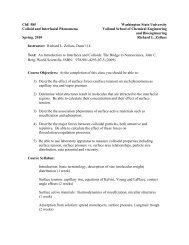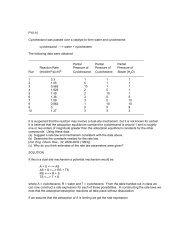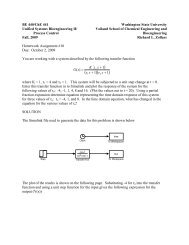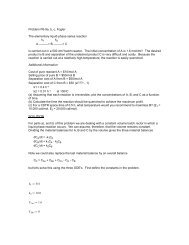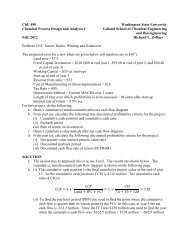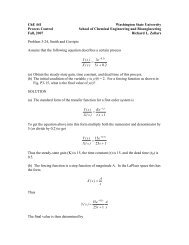To determine whether the reaction behaves as a stoichiometrically ...
To determine whether the reaction behaves as a stoichiometrically ...
To determine whether the reaction behaves as a stoichiometrically ...
You also want an ePaper? Increase the reach of your titles
YUMPU automatically turns print PDFs into web optimized ePapers that Google loves.
<strong>To</strong> <strong>determine</strong> <strong>whe<strong>the</strong>r</strong> <strong>the</strong> <strong>reaction</strong> <strong>behaves</strong> <strong>as</strong> a <strong>stoichiometrically</strong> simple <strong>reaction</strong>,<br />
apply <strong>the</strong> Law of Definite Proportions by calculating ξ for each species. These<br />
calculations are summarized in <strong>the</strong> following table:<br />
Species ∆n i v i ξ<br />
C 4 H 4 S -70.0 -1 70.0<br />
H 2 145.9-410.9=265.0 -4 66.25<br />
C 4 H 10 75.1-20.1=55.0 +1 55.0<br />
H 2 S 95.7-25.7=70.0 +1 70.0<br />
These calculations show that <strong>the</strong> <strong>reaction</strong> is not behaving <strong>as</strong> though it were<br />
<strong>stoichiometrically</strong> simple. Why not The data provides some clues. The above<br />
calculation show that <strong>the</strong> amount of hydrogen sulfide (H 2 S) being formed is in exact<br />
proportion to <strong>the</strong> amount of thiophene being consumed. However, less hydrogen is being<br />
consumed than predicted by <strong>the</strong> balanced stoichiometrical equation, given <strong>the</strong><br />
consumption of thiophene, and less butane (C 4 H 10 ) is being produced.<br />
If we checked <strong>the</strong> elemental balances at this point, <strong>the</strong>y would show that all of <strong>the</strong><br />
sulfur atoms were accounted for (in = out), but that <strong>the</strong>re were fewer hydrogen and<br />
carbon atoms leaving than entering. It seems likely that <strong>the</strong> analytical system in <strong>the</strong> pilot<br />
plant h<strong>as</strong> failed to detect at le<strong>as</strong>t one hydrocarbon species, and that this undetected<br />
species h<strong>as</strong> a lower H/C ratio than butane. If <strong>the</strong> behavior of <strong>the</strong> system cannot be<br />
described by one <strong>stoichiometrically</strong> simple <strong>reaction</strong>, perhaps more than one <strong>reaction</strong> is<br />
taking place. Following is one possible example that might have occurred:<br />
Ex) Suppose that two <strong>reaction</strong>s shown below were taking place in <strong>the</strong> thiophene<br />
hydrogenolysis pilot plant mentioned in Example 1-1.<br />
C 4 H 4 S + 3H 2 C 4 H 8 + H 2 S<br />
(A)<br />
C 4 H 8 + H 2 C 4 H 10<br />
(B)<br />
Are <strong>the</strong>se <strong>reaction</strong>s <strong>stoichiometrically</strong> consistent with <strong>the</strong> pilot plant material balance<br />
data<br />
If <strong>the</strong>se two <strong>stoichiometrically</strong>-simple <strong>reaction</strong>s are sufficient to account for <strong>the</strong><br />
behavior of <strong>the</strong> actual system, <strong>the</strong>n all of <strong>the</strong> equations for ∆n i , one for each species, will<br />
be satisfied by a single value of ξ A , <strong>the</strong> extent of Reaction A, and by a single value of ξ B ,<br />
<strong>the</strong> extent of Reaction B.<br />
For thiophene (T),<br />
∆n T = v AT ξ A + v BT ξ B = -70<br />
Since v AT = -1 and v BT = 0, ξ A = 70.<br />
For H 2 (H),
∆n H = v AH ξ A + v BH ξ B = -265<br />
Since v AH = -3 and v BH = -1,<br />
(-3)(70) + (-1)ξ B = -265; ξ B = 55<br />
These values of ξ A and ξ B must now satisfy all of <strong>the</strong> remaining equations for ∆n.<br />
However, <strong>the</strong> equation for butene cannot be used since <strong>the</strong>re is no experimental value of<br />
∆n for butene.<br />
For H 2 S (S),<br />
∆n S = v AS ξ A + v BS ξ B = 70<br />
(+1)(70) + (0)(55) = 70 Check<br />
For butane (B),<br />
∆n B = v AB ξ A + v BB ξ B = 55<br />
(0)(70) + (1)(55) = 55 Check<br />
Therefore, <strong>the</strong> data, <strong>as</strong> it exists, is consistent with Reaction A and B. This analysis does<br />
not prove that <strong>the</strong> above two <strong>reaction</strong>s are taking place.<br />
There are o<strong>the</strong>r explanations that could account for <strong>the</strong> discrepancy in data. First, it may<br />
be that <strong>the</strong> experimental data is inaccurate. Perhaps only one <strong>reaction</strong> is taking place, but<br />
<strong>the</strong> number of moles of both H 2 and C 4 H 10 have been me<strong>as</strong>ured incorrectly. Perhaps more<br />
than two <strong>reaction</strong>s are taking place. Additional data is required in order to <strong>determine</strong><br />
which is <strong>the</strong> correct possibility. Moreover, <strong>the</strong> analysis of pilot-plant operations must be<br />
improved so that all three species balances (carbon, hydrogen and sulfur) close to within<br />
re<strong>as</strong>onable tolerances. What specific actions would you recommend to <strong>the</strong> team that is<br />
operating <strong>the</strong> pilot plant




